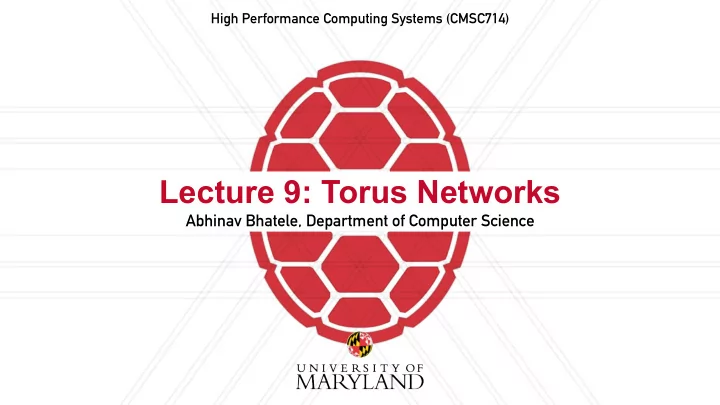

High Performance Computing Systems (CMSC714) Lecture 9: Torus Networks Abhinav Bhatele, Department of Computer Science
Announcements • Assignment 2 on OpenMP is online: due on October 7 Abhinav Bhatele, CMSC714 2
Summary of last lecture • Shared memory architectures • Distributed globally addressable memory • SGI Origin and Altix series • Directory-based protocol for cache coherence • Used hypercube and fat-tree networks Abhinav Bhatele, CMSC714 3
HPC networks • Key requirements: extremely low latency, high bandwidth • Scalable: Adding more nodes shouldn’t degrade network properties dramatically • Low network diameter, high bisection bandwidth • Compute nodes connected together in many different logical topologies Abhinav Bhatele, CMSC714 4
n -dimensional Torus Networks • Specific case of k -ary n -cube networks • k = number of nodes in each dimension, n = number of dimensions • 2-dimensional mesh: k-ary 2-cube • 3-dimensional mesh: k-ary 3-cube • Torus networks: add wraparound links to the corresponding mesh network https://en.wikipedia.org/wiki/Torus_interconnect Abhinav Bhatele, CMSC714 5
Routing protocols • Minimal hop / shortest-path routing • Static (dimension-ordered) or dynamic (follow path of least congestion) • Switching techniques • Virtual cut-through, wormhole Switching techniques: http://pages.cs.wisc.edu/~tvrdik/7/html/Section7.html#AAAAABasic%20switching%20techniques Abhinav Bhatele, CMSC714 6
History of torus computers • Cray T3D was launched in 1993 • 300 MB/s of bandwidth in each direction • Cray T3E, XT3/4/5 (SeaStar), XE6/XK7 (Gemini) - 3D tori • IBM Blue Gene/L/P (3D torus) • IBM Blue Gene/Q (5D torus with E dimension of size 2) • Fujitsu Tofu interconnect (6D torus) History: https://www.extremetech.com/extreme/125271-the-history-of-supercomputers Abhinav Bhatele, CMSC714 7
Blue Gene/L: Five networks • 3-dimensional torus: 64 x 32 x 32 = 65,536 nodes • Build block: 1 mid plane of 8 x 8 x 8 nodes 6 7 8 • Collective network 1 32 � 32 � 32 • Integer reductions, broadcast Logical x cables 2 8 � 24 � 32 Logical z cables 3 8 � 8 � 16 • Barrier network 4/5 Two 8 � 8 � 8 Logical y cables 6 24 � 16 � 32 • Gigabit Ethernet 7 24 � 8 � 32 8 24 � 8 � 32 1 • Parallel I/O 2 3 • Control system network (Ethernet) Abhinav Bhatele, CMSC714 8
Cray Gemini network • Each Gemini router switch has 2 nodes attached to it • 2 pairs of links in the X and Z dimensions, one in the Y dimension Abhinav Bhatele, CMSC714 9
Questions Blue Gene/L torus interconnection network • What are CRC codes? • How do mesh network topologies deadlock? How does the bubble escape set of rules help? • What does it mean to connect each rack with its next-to-nearest neighbor • Why packets can be forwarded before being entirely received? Abhinav Bhatele, CMSC714 10
Questions The Gemini System Interconnect • Why did the Cray designers choose to have phits be composed of 24 bits? Does it have to do with the number of lanes in a link (3) sending a byte each? • Does the Cray system use a CRC code to check integrity of the header phit? • When do the costs of more complex headers for data transmission outweigh the bandwidth losses? • Since Gemini supports global address space programming, does it mean that we can use some shared memory programming model on it? • How is “transfer data directly between nodes without OS intervention” achieved? Abhinav Bhatele, CMSC714 11
Questions? Abhinav Bhatele 5218 Brendan Iribe Center (IRB) / College Park, MD 20742 phone: 301.405.4507 / e-mail: bhatele@cs.umd.edu
Recommend
More recommend